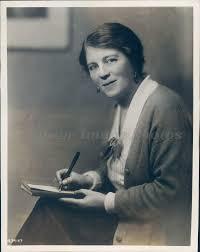Book Review by George S: Naomi Royde-Smith is probably best-remembered for her career as a literary journalist, first on the Westminster Gazette (where she ran the celebrated competition pages) and later on Time and Tide, but she also wrote twenty-six novels. These gained respectful reviews, but were not hugely successful at the time, and have attracted little interest since.
 Naomi Royde-Smith
Naomi Royde-Smith
Skin-Deep or Portrait of Lucinda, was published in 1927, and was her third novel. Its subject is beauty.
(I should warn you that this review contains spoilers.)
The prologue tells of Arabell Holdenbrook, an American women who when young is entranced by Sargent’s painting of the stunningly beautiful Lucinda, Duchess of Merioneth. This portrait encapsulates for her everything that is dignified, historic and wonderful about the English. It is a long while before she is able to visit England, but when she does she sees the beautiful Lucinda in a box at the theatre, old now, but still stunningly beautiful. She also hears a rumor about the birth of the Duchess’s children that shocks her deeply.
After this prologue, the novel goes back to 1909, some ten years after the scandalous events. We gradually gather(through flashbacks within flashbacks – the novel is cleverly structured) that the Duchess’s marriage to the Duke broke down very quickly, and that their family is not at all what it seems. The twin girls are the children of the Duchess, but their father is the Duke’s secretary, who is enslaved by her beauty. The son and heir is the Duke’s, but by another woman.
At first the novel encourages us to see Lucinda as merely beautiful and charming, though intellectually limited. There is a passage about her love of books. She always buys the latest fashionable volumes, and really enjoys cutting their pages:
She loved the cool smoothness of ivory and jade against her palm. She loved the movements of her own hand; the supple turning of the wrist; the tips of her fingers rosy against white pages; the slimness of her fingers, adorable between thin pages, the swift action of a ringed hand brushing away the little curls of of pulp where the pages were thick and fluffy…
And so on at some length. We are told that
Sometimes, of course, she read a page here and there, and she generally remembered a phrase, or a picture if the book were illustrated; remembered enough to talk about it, which was the chief thing.
Gradually Lucinda is exposed as a monster of egotism, especially when she notes the first small signs that her beauty is fading, and she devotes her life to cosmetic treatments. The satirical chapters describing these treatments and the plausible characters who promote them are very good reads.
The disparity between Lucinda’s image and the reality of the work by which she sustains it grows. The book’s Epilogue shows the American, Arabell Holdenbrook, at a cosmetic studio, catching just a glimpse of the lovely Lucinda, working relentlessly away on an exercise bicycle inside a Turkish Bath cabinet. A while later, when Dorothy Sayers asked Naomi Royde-Smith to contribute to an anthology of horror stories, she demanded something that would make her flesh creep, like the ending of Skin-Deep.
The head too was jerking on its hidden neck, as though shaken by the efforts of the body inside the case. [….] The eyes were closed; the pale mouth was open and a restless tongue moved from side to side, projecting over the lower teeth. Sweat poured over the cheeks and made glistening runnels on their dry flushed surface. The skin was gray and lifeless except where, just below the roots of the hair, a red scar ran up the side of the face and across the top of the forehead from ear to ear. The flesh at the edge of the scar was faintly puckered, and little grooves invaded the face her and there along its line, pushing their gradual way downwards, heralds of the final ruin they and their still invisible fellows would accomplish in due time.
Skin-Deep is not a nice book. It is maybe rather a cruel one. I can see why it would not have been popular with the women who wanted a nice bit of middlebrow comfort from Boots Library every week. But it’s very sharply written, and I’d definitely recommend it to anyone who is interested in the history of costume – the descriptions of clothes are wonderfully detailed. I’m going to read some more Naomi Royde-Smith.
P.S. N R-S was also the author of the poem:
I know two things about a horse
And one of them is rather coarse.
